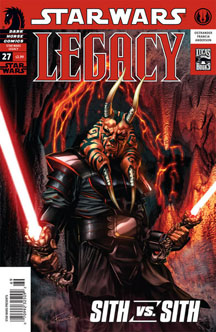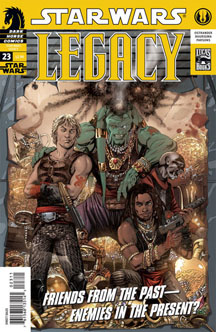Coming off Cade Skywalker’s epic escape from the Sith Temple in the previous arc, “Legacy” Issues 20-27 (2008) mark an opportunity for the series to catch its breath. Rather than being a boring stretch of issues, it is enjoyable to bask in this world writer John Ostrander has constructed, especially since he shines with dialogue and humor when the stakes aren’t so high.
This is a good place to mention the attention to detail Ostrander pours into the “Legacy” universe. Much like Joss Whedon had the crew of the Serenity swearing in Chinese in the future-set “Firefly,” the heroes of “Legacy” often use Huttese words. For example, the gang is hanging out at Cade’s uncles’ hideout and enjoying a meal. Jariah Syn tells young Ahnah: “Na joka, Ahnah. I’d always choose you. With deep regret for having lost that bilaberry patogga.”
The new Lucasfilm Story Group, which aims to appeal to the lowest common denominator, would probably prefer that line said, “No kidding, Ahnah. I’d always choose you. With deep regret for having lost that blueberry pie.” But the use of Huttese not only makes this fictional universe feel different from Earth, it also makes the audience feel intelligent – even though it doesn’t take a Death Star superlaser technician to put together the image of a blueberry pie with the words “bilaberry patogga.”
In “Loyalties” (Issues 23-24), Ostrander introduces another Skywalker: Cade’s uncle (and Kol’s brother), Nat Skywalker, who now goes by the name Bantha Rawk and hides out with his family in the Rawk’s Nest — much like Sarah Connor’s heavily armed friends have a compound south of L.A. in “Terminator 2: Judgment Day.” When Cade and his friends on the Mynock arrive, Bantha and his family are successfully fighting off Black Sun bandits.
Bantha’s life illustrates an option for Cade and his “I just want to be left alone” outlook, but Bantha outlines the sacrifices: changing you name, appearance, friends and ship, “and don’t ever use the Force again.”
“That’s just surviving, Uncle Bantha,” Cade realizes. “That’s not living – not like I want it. I got a fast ship and friends I trust at my back. I like living on the fringes and I just want my freedom.”
“The Hidden Temple” (25-26) includes some tasty material, including the backstory of why Syn loathes Jedi. But when he honestly examines his memories, Syn realizes the Jedi who killed his dad was actually protecting a group of roon stone prospectors (a nice shout-out to the “Droids” cartoon) and Syn’s dad and pirate boss were the aggressors.
I didn’t care much for the accusation by the Jedi in the Hidden Temple that Cade is in danger of going to the dark side. Because he doesn’t have a power-craving bone in his body, Cade – compared to Ulic, Quinlan and even Luke – was uniquely prepared to overcome an infiltration of Darth Krayt’s sanctum. The Jedi leadership’s assertion that Jedi don’t do assassinations is even more absurd, especially in light of Darth Krayt’s recent actions.

With the Galactic Alliance Remnant on the brink of total defeat, Admiral Gar Stazi finagles a clever military victory in “Indomitable” (20-21). That sparks Krayt to order the slaughter of 10 percent of the population of Dac (a.k.a. Mon Calamari) in “The Wrath of the Dragon” (22) – an action that had me thinking “Krayt just overplayed his hand, and this will mark the turning point of the war.” It’s not an idle threat, as in “Loyalties,” our heroes hear a news report that the Sith Empire has indeed killed 10 percent of Dac’s population with the rest in the process of being rounded up for slave camps.

In arguing to sit this war out, the Jedi Council in the Hidden Temple brings up a valid point that Krayt might soon die on his own. That brings us to “Into the Core” (27), where Darth Wyyrlok infiltrates the tomb of Darth Andeddu looking for more Sith secrets on how to prolong the life of Krayt, who started life as the human A’Sharad Hett way back in “Republic.” Krayt’s loyal aide had devised a stasis chamber for his master, but that might no longer be enough.
Wyyrlok is an interesting tie-in to prior eras, but not because he is long-lived like Krayt and Jedi Masters K’Kruhk and T’ra Saa (who enters the “Legacy” narrative in “The Hidden Temple”). Rather, “Legacy’s” Darth Wyyrlok (III) is the grandson of the male Darth Wyyrlok (I) from the novels “Crosscurrent” and “Riptide,” and the son of the female Darth Wyyrlok (II). All three generations have served as Krayt’s aide.
The second-most absurd argument (behind “Assassinations aren’t the Jedi way”) the Jedi Council uses for not getting involved is that the next Sith leader could be even worse. Really, worse than someone who successfully inspires his troops to kill 10 percent of a planet’s population overnight? If Krayt is not worthy of being assassinated, no one is, and frankly, there’s not a lot of point for the Jedi Order to exist.
While the Jedi sit this one out, the Imperial Knights agree to join Cade on this new mission to face Krayt, putting me in the odd position of rooting for Imperials rather than Jedi. But putting new twists on old “Star Wars” concepts is part of the appeal of “Legacy.”

